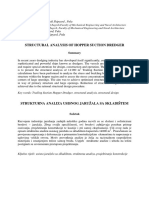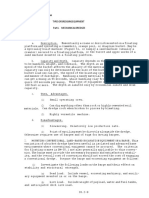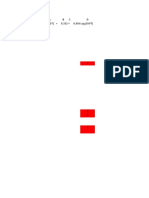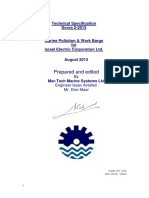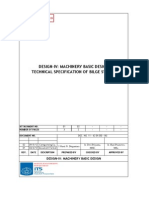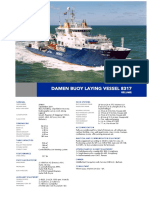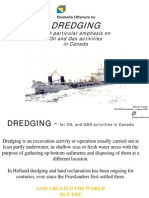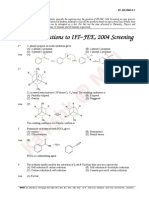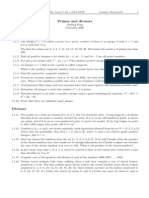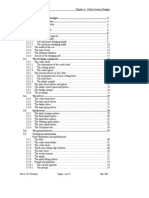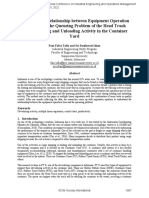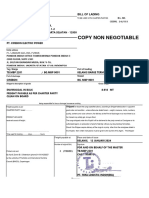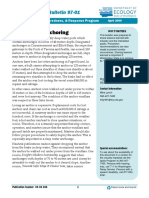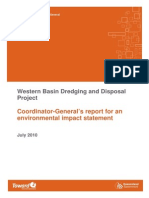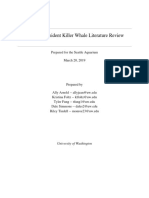Dredging
Dredging
Uploaded by
sanjivsingCopyright:
Available Formats
Dredging
Dredging
Uploaded by
sanjivsingOriginal Description:
Copyright
Available Formats
Share this document
Did you find this document useful?
Is this content inappropriate?
Copyright:
Available Formats
Dredging
Dredging
Uploaded by
sanjivsingCopyright:
Available Formats
8.
The backhoe or Dipper dredger
Figure 8. 1 BHD IJZEREN HEIN,
8.
8.1. 8.2. 8.3. 8.4. 8.5. 8.6.
The backhoe or Dipper dredger ..............................................................................1 General considerations .......................................................................................1 Working method ................................................................................................2 Area of application .............................................................................................4 Main Layout.......................................................................................................5 Production capacity ............................................................................................9 Cylinder forces................................................................................................. 10
8.1. General considerations
A backhoe dredge is a stationary tool, anchored by three spuds: two fixed spuds at the front (starboard and portside) and a moveable spud at the back of the pontoon (see Figure 8. 1and Figure 8. 10). Hydraulic dredgers are available in two models, the backhoe (Figure 8. 1) and the dipper or front shovel (Figure 8. 1 ). The first is used most. The difference between those two is the working method. The backhoe pulls the bucket to the dredger, while the front shovel pushes. The last method is only used when the water depth is insufficient for the pontoon.
Figure 8. 2 Backhoe dredger
Figure 8. 3 front shovel or dipper dredger
Due to the anchoring by spud poles and the fixed boom and stick the dredging depth is limited (maximum 25 m). Some of these type of dredgers are self propelled. In 1999, the biggest Backhoe dredger in the world was delivered by Shipyard "De Donge" to "Great Lakes Dredge & Dock Co". This dredger is equipped with a Liebherr P996 excavator and can dredge with a 13 m3 bucket till an approx. 17 m. depth. The dredge can however dredge till a maximum depth of 30 m. in case the boom / stick configuration is changed. The maximum penetration/ breakout capacity is 170 tons! The weight of the excavator 470 tons!
8.2. Working method
Figure 8. 4 Cylinders on boom and stick
During dredging the pontoon is lifted partly out of the water to create sufficient anchoring. Besides that the dredger is in that case less sensible for waves. The bucket is positioned and excavates the soil by means hydraulic cylinders on the boom and stick (Figure 8. 4). The effective dredging area depends on the swing angle and the forward step per pontoon position, which on his turn depends on the length of the boom and stick. On the mooring side for the barges the swing angle is restricted. Swinging over the other side is mostly restricted 60 Larger angles are less effective (Figure 8. 5). The method is the same as for cable cranes.
Rsin
A eff = R sin L =
2 RL 360
L=S
Cut projection
Step
Effective Area
Top view cut
Average width cut
L'
End last cut
S
Effective Width
R 2 R S R
End this cut
Figure 8. 5 Effective dredging area
The forward step per pontoon positions can be sub-divided in bucket forward positions (Step) and bucket swing positions (width) (Figure 8. 1). A small step results in a large width and a large step in a small width to fill the bucket, however the total volume is almost the same.
Volume V
Width
Step
Figure 8. 6 bucket forward (step) & bucket swing (width) positions
Due to the radius of the boom and arm the cut width is limited to 10 to 30 m, see (Figure 8. 7). The dredge has sometimes more than one boom and/or sticks. A shorter boom and / or stick result in higher excavating forces.
19 18 17 16 15 14 13 12 11 10 9 8 7 6 5 4 3 2 1 0 1 2 3 4 5 6 7 8 9 10 11 12 13 14 15 16 17 18 19 20 28 27 26 25 24 23 22 21 20 19 18 17 16 15 14 13 12 11 10 9 8 7 6 5 4 3 2 1 0
Figure 8. 7 The reach of the dredger for different booms & sticks 1.
8.3. Area of application
Backhoes are used in soil types like firm clay, soft rock, blasted rock and when large stones can be expected, like the removal waterside protections. The length of the stick and the boom determines the dredging depth. Some backhoes have more than one bucket to be able to dredge well at several depths. The lack of anchorage cables limits the hindrance for other ships and there is also no delay for anchorage. Hydraulic backhoes are especially suitable for accurate dredge work, due to the construction of the stick and the boom. In general this dredge tool cannot be used under offshore conditions, due to the limited pontoon width. Since there are several ways of defining the volume of the buckets one has to be aware when ordering one. The definitions are (Figure 8. 8): struck capacity (water volume): this is the amount of water that the bucket can hold at maximum when the upper bucket rim is held horizontal.
heaped capacity (SAE volume (SAE = Society of Automotive Engineers)): in this an extra amount of soil with embankment slopes of 1:1 is calculated in. heaped capacity CECE volume (CECE = Committee of European Construction Equipment): same as above but with embankment slopes of 1:2.
afstrijkhoogte
Water Capacity
1 1
1 1 1
1 1
SAE Capacity
CECE Capacity Figure 8. 8 Different capacities
Mainly the type of soil determines the filling degree of the bucket. In soft and sticky soils the bucket is heaped, while in rock due to the shape of the boulders only a part of the bucket is filled. Besides, the bulking (volume increase) from the soil plays a role too. Soil type Soft clay Hard clay Sand & Gravel Rock; well blasted Rock, unblasted Filling degree 1.5 1.1 1 0.7 0.5 Bulking factor 1.1 1.3 1.05 1.5 1.7
8.4. Main Layout
The crane is positioned on the front side of the pontoon on the turning table, which situated just above water level. This part is a compromise between the required freeboard and the maximum available excavating force. The required reaction forces for excavations are delivered by the spud-poles. The crane on the turning table is mostly from a well-known brand (Demag, Liebherr, O&K Poclain, etc.), which can be delivered in modules (Figure 8. 1). The boom and stick are constructed more heavy duty than those for land operations. Marine operations results in higher and more dynamic loads due to deep excavation depths. Bucket sizes vary from several cubic meters to 20 m3. The spud are provided with a hoisting system to hoist the spuds from the sea bed as well as to lift the pontoon partly out of the water to increase the transfer of the reaction forces to the Figure 8. 9 Shovel modules soil The aft spud is either placed in a carriage (Figure 8. 10) or is executed as a walking spud (Figure 8. 11).
The engine room and the accommodation is place at the stern. .
Figure 8. 10 General plan BHD IJZEREN HEIN
The backhoe dredge IJzeren Hein is equipped with a Liebherr P 984 crane and is build under the classification of Burea Veritas I 3/3 (-) Pontoon NP/Deep Sea.
Figure 8. 11 Plan view BHD ROCKY, Owner BOSKALIS
The BHD Rocky, one of the most powerful backhoes, is provided with a DEMAG H 286S excavator with 1230 kW and can be equipped with bucket varying in size between3 and 16 m3. She has a dredging depth of 25 m. The aft spud is executed as a walking spud. Data from existing backhoe dredgers shows that there is hardly a relation between bucket size and installed diesel power as well as between diesel power and lightweight (Figure 8. 12 and Figure 8. 13).
1200.00 1000.00 Installed power [kW] Light weight [t] 5.00 10.00 Bucket size [m3] 15.00 20.00 800.00 600.00 400.00 200.00 0.00 0.00 1800 1600 1400 1200 1000 800 600 400 200 0 0 250 500 750 1,000 1,250 Total installed power [kW]
Figure 8. 12Relation bucket capacity versus installed diesel power
Figure 8. 13 Relation bucket installed diesel power versus light weight of the pontoon
Lightweight of the pontoon is some what related to the total power installed (, while lightweight is roughly 47 % of the pontoon volume (Figure 8. 16 and Figure 8. 17).
Data from excavator suppliers shows a better relation.
30 25 Bucket size [m3] 20 15 10 5 0 0 100 200 300 Crane weight [ton] 400 500 600
Power [kW]
Liebherr Excavators
y = -7E-06x + 0.0494x + 1.5486 R = 0.9778
2 2
2500 2000 1500 1000 500 0 0 100 200 300 400 500 600 Crane weight [tons] y = 4.4679x R2 = 0.9936
Figure 8. 14
Figure 8. 15
Data from Liebherr Excavators With Figure 8. 14 and Figure 8. 15 a better estimate of the installed power is possible then from Figure 8. 12.
1800 1600 1400 Light weight [t] 1200 1000 800 600 400 200 0 0 500 1000 1500 LBD [m3] 2000 2500 3000 y = 0.4713x R = 0.6122
2
Figure 8. 16 Pontoon volume versus lightweight
Length-width ratio and width-draught ratio are almost the same as for the pontoons of the grab dredgers (Figure 8. 17).
L/B 9.00 8.00 7.00 6.00 5.00 4.00 3.00 2.00 1.00 0.00 0 200 400 600 800
B/T
L/B & B/t
1,000
1,200
1,400
1,600
1,800
Light weight [t]
Figure 8. 17 Lightweight versus pontoon dimensions.
8.5. Production capacity
When dredging soft soils (free running sand, silt and soft clay) the volume per bite of the bucket is determined by the bucket capacity. For harder materials the cylinder forces can be the decisive factor. If the cylinder force is Fc and the cutting speed vc and the specific energy of the soil is SPE then:
Fc v c SPE = Qs =
With:
Vbucket d layer step Wbucket = t digging t digging
Production Bucket capacity Excavating time Thickness layer Step size Width of bucket
Qs Vbucket Tdigging dlayer Step Wbucket
m3/s m3 s m m m
The cutting speed can be calculated either by rotating the bucket or the stick. Cycle times of the bucket depends on the dredging depth and soil type, but are in the order between 20 and 40 seconds. The cycle consists of: Digging Lifting and swinging Dumping Swinging and lowering Positioning. The step procedure takes more time, 5 to 10 minutes. No. 1 2 3 4 5 6 7 8 9 STEP PROCEDURE FOR BACKHOE DREDGERS Spud carriage Walking spud Lower pontoon into the floating position Lower pontoon into the floating position Put the bucket into the soil Put the bucket into the soil Lift front spuds Lift front spuds Move pontoon one step forward by Move pontoon one step forward by tilting moving the carriage and the stick. the walking spud and pulling the stick. Set front spud into the soil Set front spud into the soil Lift walking spud Lift movable spud Tilt waling spud back into its middle Move carriage one step forwards position Lower walking spud Set the movable spud into the soil Lift pontoon in working position Lift pontoon in working position
Points 6, 7 and 8 for the spud carriage system are only necessary when the stroke of the cylinder to move the carriage is used.
8.6. Cylinder forces
The cutting forces are calculated either by the specific energy concept or by the cutting theories for sand, clay or rock. The cutting theories give the normal forces too, however for sharp knives or teeth only. For design purposes the average normal forces (between sharp and blunt cutting tools) are assumed to be a ratio of the cutting forces. For sand and clay Fcutting/Fnormal =10 and for rock Fcutting/Fnormal =2 If the ratio is known, the cylinder forces can be calculated by taking the moments around the suspension points. The cylinder force to move the boom follows from the equation (Figure 8. 18):
Fcylinder =
Fc d + Fp l Wboom zboom Wstick zstick Wbucket zbucket a
l a zboom Wboom
zstick Wstick zbucket Wbucket
Figure 8. 18 Forces on the boom and stick
Finally, the moments and shear forces can be calculated in the boom and stick to depend the dimensions of the boom and stick under dynamic conditions.
You might also like
- Reeds Nautical Almanac 2023 PDFDocument1,236 pagesReeds Nautical Almanac 2023 PDFAndrei C83% (6)
- CES 6 0 9 DetailedTest CargoHandlingAndStowage Management OilTankersDocument9 pagesCES 6 0 9 DetailedTest CargoHandlingAndStowage Management OilTankerstarasevychmaxNo ratings yet
- Mooring Assessment FormDocument4 pagesMooring Assessment FormSAGAMINo ratings yet
- Truxor 09 ENG2 PDFDocument16 pagesTruxor 09 ENG2 PDFProjetos TonioloNo ratings yet
- Tuas Yard Layout 2013 PDFDocument1 pageTuas Yard Layout 2013 PDF01301112No ratings yet
- New Dry Dock Proposed at Pearl HarborDocument1 pageNew Dry Dock Proposed at Pearl HarborHonolulu Star-AdvertiserNo ratings yet
- Data Sheet TSHD 5000: GeneralDocument2 pagesData Sheet TSHD 5000: GeneralOvan Indra Abdi Pamungkas100% (1)
- New Gen DredgersDocument1 pageNew Gen DredgersViswanatham MarellaNo ratings yet
- BargeDocument5 pagesBargeBudimanNo ratings yet
- Technical Specifications TSHD Jan de NulDocument4 pagesTechnical Specifications TSHD Jan de NulRavael SimanjuntakNo ratings yet
- Structural Analysis of Hopper Suction DredgerDocument10 pagesStructural Analysis of Hopper Suction DredgerIvan GrbavacNo ratings yet
- QMS System References PDFDocument2 pagesQMS System References PDFAbdhel X-Meta100% (1)
- FoundOcean Fabric Formwork Grout Bag CatalogueDocument20 pagesFoundOcean Fabric Formwork Grout Bag Cataloguejptl6477No ratings yet
- Neha JNPTDocument14 pagesNeha JNPTGaurav SinghNo ratings yet
- EDC Rig 62Document1 pageEDC Rig 62Tim ClarkeNo ratings yet
- Al Mirfa: 10,500kW Cutter Suction DredgerDocument1 pageAl Mirfa: 10,500kW Cutter Suction DredgerSeaworks CompanyNo ratings yet
- Floating Coal Teriminal PpeDocument8 pagesFloating Coal Teriminal Ppebetahita_80174No ratings yet
- Oecd Shipbuilding Workshop KokubunDocument21 pagesOecd Shipbuilding Workshop KokubunBenjamin StricklandNo ratings yet
- Marine Fender PDFDocument44 pagesMarine Fender PDFDiguinho PiresNo ratings yet
- Safeloading PDFDocument54 pagesSafeloading PDFFradj100% (1)
- Damen Cutter Suction Dredger 650Document2 pagesDamen Cutter Suction Dredger 650Fajrin M. Natsir100% (1)
- MPS Factsheet JU3620Document2 pagesMPS Factsheet JU3620Booraj DuraisamyNo ratings yet
- Tipe Perlengkap Pengerukan Types of Dredging Equipment Part 1. Mechanical DredgesDocument15 pagesTipe Perlengkap Pengerukan Types of Dredging Equipment Part 1. Mechanical Dredgesfathurahmad 2205No ratings yet
- Technical Inputs To Dredging Cost Estimates: June 2011Document15 pagesTechnical Inputs To Dredging Cost Estimates: June 2011PRmani RamalingamNo ratings yet
- Offshore Workspace WP2 Task 7b Alternative Installation MethodsDocument27 pagesOffshore Workspace WP2 Task 7b Alternative Installation MethodsNguyễn Văn BanNo ratings yet
- Detail of Leg Model PDFDocument1 pageDetail of Leg Model PDFRaj P. AbhaleNo ratings yet
- Marine Loading ArmDocument2 pagesMarine Loading ArmAfolabi OlaniyiNo ratings yet
- Jetty Construction Planning at Southern Manhattan, New York, USADocument10 pagesJetty Construction Planning at Southern Manhattan, New York, USANorman SevenFoldNo ratings yet
- FenderDocument17 pagesFenderharrys manaluNo ratings yet
- Chapter 4 - Buoyancy StabilityDocument36 pagesChapter 4 - Buoyancy StabilityncrlccNo ratings yet
- Production Process of Fiberglass Fast Interceptor Boat in MalaysiaDocument7 pagesProduction Process of Fiberglass Fast Interceptor Boat in MalaysiaShyam SNo ratings yet
- Dynamic Simulation of Cutter Dredger at SeaDocument8 pagesDynamic Simulation of Cutter Dredger at Seaivkenavarch100% (1)
- Catalogue Fenders ParameterDocument28 pagesCatalogue Fenders ParameterAlif Aikal Che HatNo ratings yet
- Technical Proposal-NAMDocument8 pagesTechnical Proposal-NAMnavalarchmarineNo ratings yet
- Electrical Load AnalysisDocument14 pagesElectrical Load AnalysisTECH2982No ratings yet
- Manufacturing Techniques of FRP CompositesDocument34 pagesManufacturing Techniques of FRP Compositesanon_945096555No ratings yet
- Article Dredging Rock With A Hopper Dredger The Road To The Ripper Draghead 118 4Document9 pagesArticle Dredging Rock With A Hopper Dredger The Road To The Ripper Draghead 118 4Ronnie oliveiraNo ratings yet
- Liebherr Offshore Cranes Product Range - enDocument11 pagesLiebherr Offshore Cranes Product Range - enHugo Vco RvaNo ratings yet
- Camarc SAR 2015Document2 pagesCamarc SAR 2015Syaiful Anam100% (1)
- Barge SpecificationDocument3 pagesBarge SpecificationPrexi DeprexerNo ratings yet
- Data Mooring LoadDocument22 pagesData Mooring LoadshivaniNo ratings yet
- Anx B Specification Dovra-2-2013Document33 pagesAnx B Specification Dovra-2-2013agusfaizinNo ratings yet
- Mumbai FSRU 0 - 0 - 16 - Dec - 2014 - 1926498671IITM-MBPT-FSRU-0003-RevCDocument136 pagesMumbai FSRU 0 - 0 - 16 - Dec - 2014 - 1926498671IITM-MBPT-FSRU-0003-RevCPatrick YapNo ratings yet
- Mumbai High North Area TeamDocument5 pagesMumbai High North Area TeamBiswa PatnaikNo ratings yet
- Dura RampDocument8 pagesDura RampAshley Dean100% (1)
- soo-NAH - Mee Tsoo - NAH - Mee (2) : TsunamiDocument2 pagessoo-NAH - Mee Tsoo - NAH - Mee (2) : TsunamiBharath KumarNo ratings yet
- Book 11 (BGW)Document13 pagesBook 11 (BGW)dirgan_udyanaNo ratings yet
- Quiz I - 2017-AnswersDocument5 pagesQuiz I - 2017-AnswerssubhashNo ratings yet
- Yacht General Arrangement DrawingDocument1 pageYacht General Arrangement Drawingking852No ratings yet
- Buoy Laying Vessel 8317 YN554001 RelumeDocument2 pagesBuoy Laying Vessel 8317 YN554001 RelumeJhon GreigNo ratings yet
- Presentation FWEL-I&IIDocument67 pagesPresentation FWEL-I&IIlmkr80No ratings yet
- 2002 Rio Fpso 1stDocument269 pages2002 Rio Fpso 1stAlex Rodriguez100% (1)
- Condition Assessment Programme (CAP) : Guidance Note NI 465 DT R01 EDocument24 pagesCondition Assessment Programme (CAP) : Guidance Note NI 465 DT R01 EFarhanNo ratings yet
- MS For Pontoon AssemblyDocument8 pagesMS For Pontoon AssemblyWASIM MAKANDARNo ratings yet
- Report Lifting Frame CKX GeneratorDocument3 pagesReport Lifting Frame CKX GeneratorJoe FizzoNo ratings yet
- Job Card WP 14-8-17Document1 pageJob Card WP 14-8-17Alif Rahmat FebriantoNo ratings yet
- Anclajes Tunja1Document3 pagesAnclajes Tunja1Diana RamosNo ratings yet
- 1 112mn0535-Infrastructure PlanningDocument18 pages1 112mn0535-Infrastructure PlanningVineet Kumar SinghNo ratings yet
- Load Dermaga BBMDocument31 pagesLoad Dermaga BBMFaridah ZahraNo ratings yet
- Penawaran Hammer CrusherDocument1 pagePenawaran Hammer CrushergloryofmajapahitNo ratings yet
- Grab or Clamshell Dredger PDFDocument17 pagesGrab or Clamshell Dredger PDFmaxamaxa0% (1)
- Fish Pond ConstructionDocument68 pagesFish Pond Constructionkunalfcri09100% (1)
- Iit Jee 2004 MathDocument7 pagesIit Jee 2004 MathLokesh KumarNo ratings yet
- DredgingDocument35 pagesDredgingsanjivsing60% (5)
- Math 2 AllDocument105 pagesMath 2 Allsanjivsing0% (1)
- Iit Jee 2004 Screening PCMDocument17 pagesIit Jee 2004 Screening PCMKainshk GuptaNo ratings yet
- Marathon ProblemsDocument18 pagesMarathon Problemsเป๋าเด็ดกระเป๋าคุณภาพราคาถูกNo ratings yet
- Math 1 AllDocument112 pagesMath 1 AllsanjivsingNo ratings yet
- Primes and Divisors: D 6 P Such That D - PDocument2 pagesPrimes and Divisors: D 6 P Such That D - PsanjivsingNo ratings yet
- Spelling Rule Cards Colour - 2Document20 pagesSpelling Rule Cards Colour - 2sanjivsing100% (1)
- Sentence CorrectionDocument10 pagesSentence CorrectionsanjivsingNo ratings yet
- Spelling RulesDocument40 pagesSpelling Rulessanjivsing100% (3)
- Spelling TrendsDocument5 pagesSpelling TrendssanjivsingNo ratings yet
- Cutter Suction DredgerDocument79 pagesCutter Suction DredgerAkash Desai100% (2)
- Number Theory Part TwoDocument3 pagesNumber Theory Part TwosanjivsingNo ratings yet
- Vlasblom1 Introduction To Dredging EquipmentDocument27 pagesVlasblom1 Introduction To Dredging EquipmentJayasankar PillaiNo ratings yet
- Project Blue Assessing The Future Trends For Financial ServicesDocument24 pagesProject Blue Assessing The Future Trends For Financial ServicessanjivsingNo ratings yet
- Cable Route Survey DictionaryDocument18 pagesCable Route Survey DictionaryginziroNo ratings yet
- CHS VLCC DatasheetDocument2 pagesCHS VLCC Datasheetksks1230% (1)
- The American Waterways OperatorsDocument7 pagesThe American Waterways Operatorsahong100No ratings yet
- 357Document13 pages357Sri Susilawati IslamNo ratings yet
- ME2134-1 Lab Manual (Stability of Floating Body)Document11 pagesME2134-1 Lab Manual (Stability of Floating Body)dasdasNo ratings yet
- Vessel Particulars VOS TritonDocument1 pageVessel Particulars VOS Tritonzba2No ratings yet
- The Bermuda Triangle (A Mystery) : BY: D.Shanmugapriyaa Msc-Data ScienceDocument14 pagesThe Bermuda Triangle (A Mystery) : BY: D.Shanmugapriyaa Msc-Data ScienceshanmugapriyaaNo ratings yet
- Model Kit Parts CountDocument1,154 pagesModel Kit Parts CountAnas YuzairiNo ratings yet
- Copy Non Negotiable: Bill of LadingDocument1 pageCopy Non Negotiable: Bill of LadingPurnama IrawanNo ratings yet
- Subject Code Exam Date Q Id Questions Answer KeyDocument16 pagesSubject Code Exam Date Q Id Questions Answer KeyGowtham RajagopalNo ratings yet
- A History of Marine Medium Helicopter Squardron 161Document60 pagesA History of Marine Medium Helicopter Squardron 161Bob Andrepont100% (2)
- Handbook of Damage ControlDocument13 pagesHandbook of Damage ControlDesri Afriliani50% (2)
- Equivalent Classification Symbols: Society SymbolDocument1 pageEquivalent Classification Symbols: Society Symbolswapneel_kulkarniNo ratings yet
- Ship ParticularsDocument2 pagesShip ParticularsBurak YıldırımNo ratings yet
- 2.the Best Position Fix Is Obtained When The Bearings of Two ObjectsDocument25 pages2.the Best Position Fix Is Obtained When The Bearings of Two ObjectsYoga PNo ratings yet
- Call Fiche Cef T 2022 Corecoen enDocument28 pagesCall Fiche Cef T 2022 Corecoen enChirim AinurNo ratings yet
- Mazaua: Magellanùs Lost Harbor: by Vicente C. de JesúsDocument83 pagesMazaua: Magellanùs Lost Harbor: by Vicente C. de JesúsDherick Raleigh33% (3)
- Deep Water Anchoring: Safety Advisory Bulletin 97-01Document2 pagesDeep Water Anchoring: Safety Advisory Bulletin 97-01Arne OlsenNo ratings yet
- History of ShipsDocument7 pagesHistory of ShipsLeafaNo ratings yet
- Dredging & Disposal ProjectDocument156 pagesDredging & Disposal ProjectRahul Kumar Awade100% (1)
- Carriege of Steel CargoDocument16 pagesCarriege of Steel CargoGeorgeImnaishviliNo ratings yet
- New Ambitions at Sea Naval Modernisation in The Gulf StatesDocument32 pagesNew Ambitions at Sea Naval Modernisation in The Gulf StatesFaisalNo ratings yet
- COLREGs Rule 26 Fishing VesselsDocument3 pagesCOLREGs Rule 26 Fishing Vesselssaiful islamNo ratings yet
- TR Cat Mrin STD Eng r00 0Document20 pagesTR Cat Mrin STD Eng r00 0Vlad AndronacheNo ratings yet
- JB 396 - Naiad Super Yacht TenderDocument1 pageJB 396 - Naiad Super Yacht TenderSagita WidyatamaNo ratings yet
- Admiralty Products Overview BrochureDocument13 pagesAdmiralty Products Overview Brochurefriends_is100% (7)
- At The World - S End Irene TrimbleDocument63 pagesAt The World - S End Irene TrimbleЛюдмила ДжумановаNo ratings yet
- Aquarium Literature ReviewDocument22 pagesAquarium Literature Reviewapi-340718677No ratings yet










